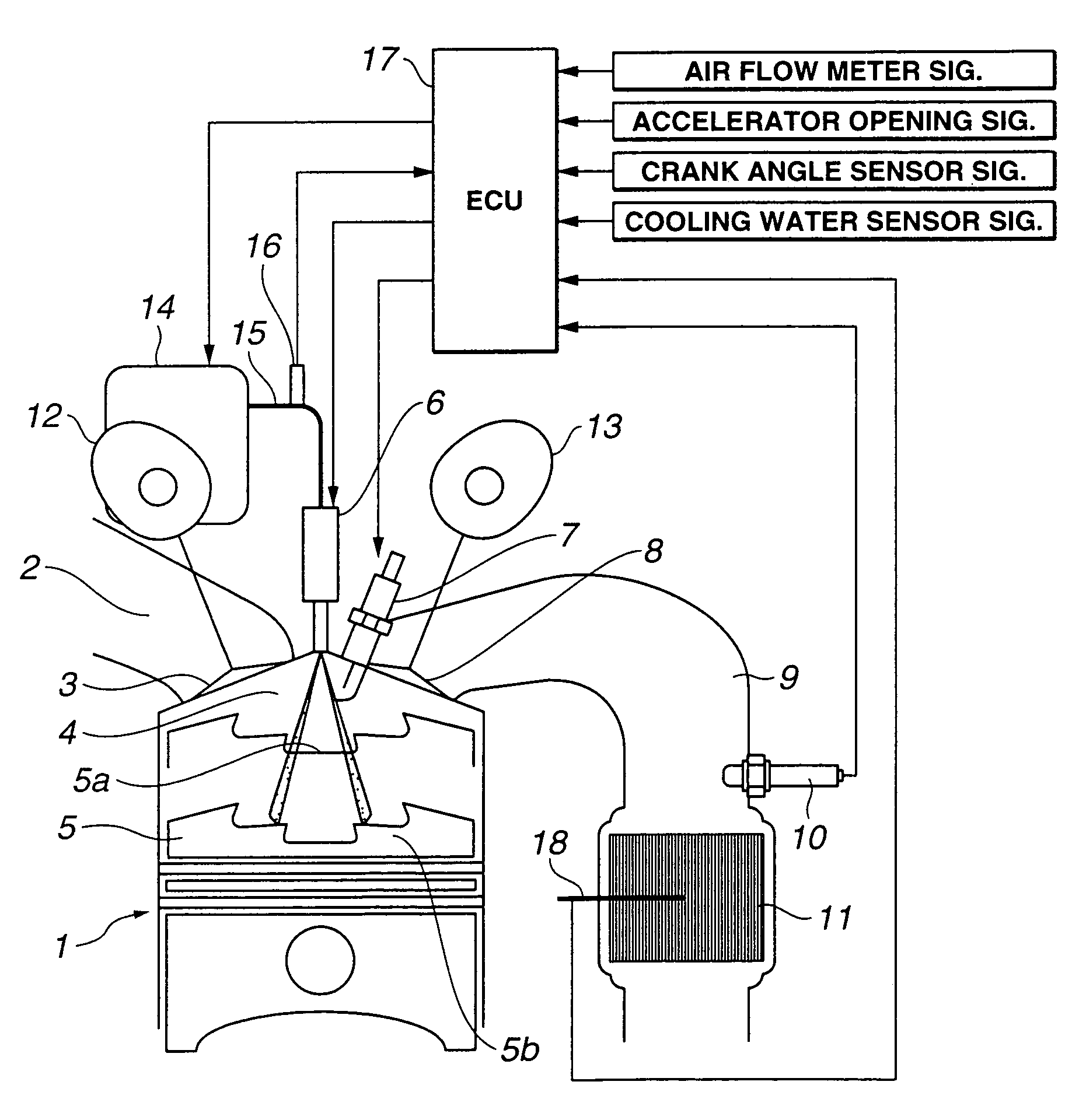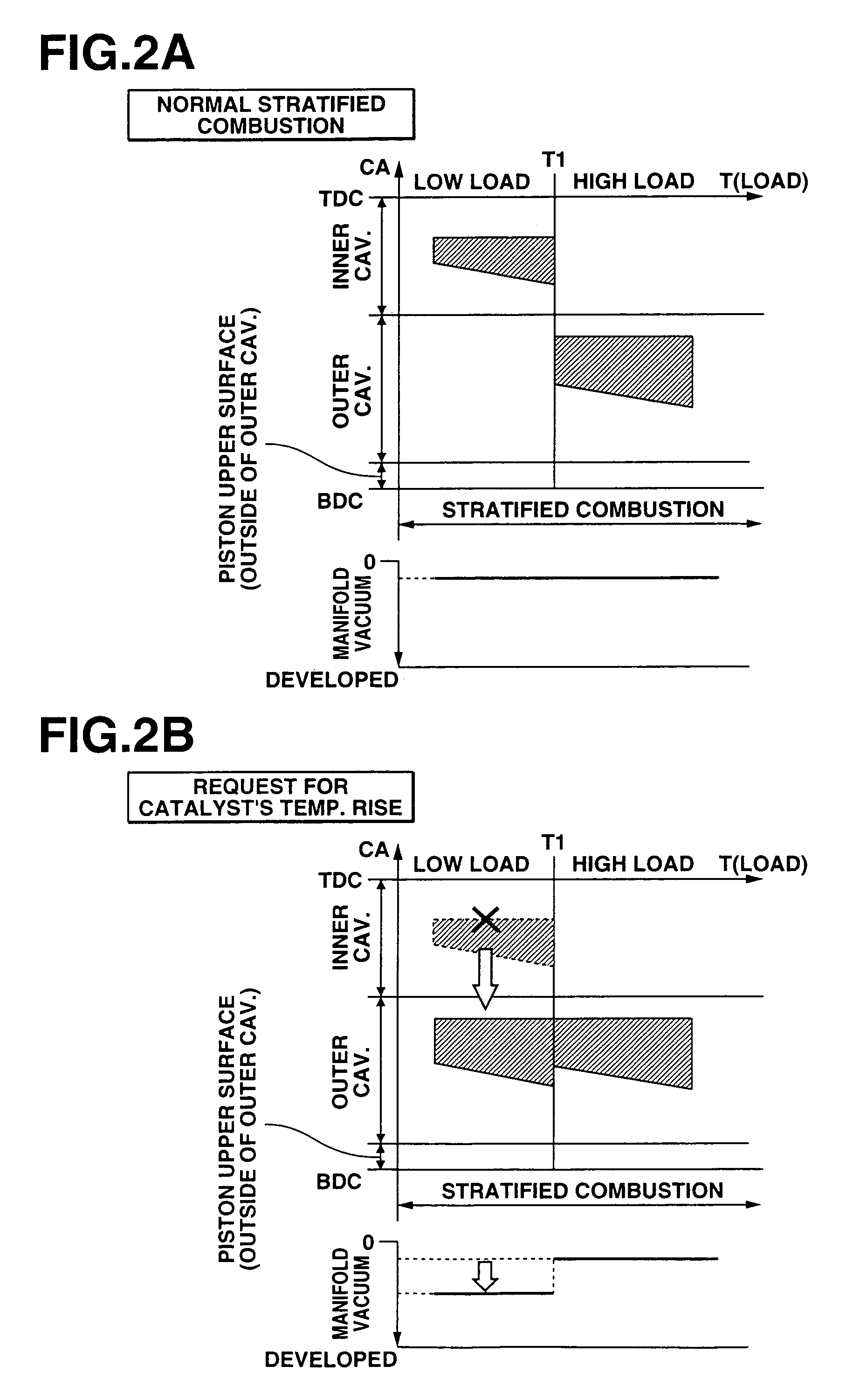Exhaust emission control apparatus and method for internal combustion engine
a technology of exhaust emission control and internal combustion engine, which is applied in mechanical equipment, electric control, machines/engines, etc., can solve the problems of deteriorating combustion stability and insufficient evaporation of fuel, and achieve the effect of effectively accelerating the early activation of the exhaust purifying catalyst and setting the ignition timing rang
- Summary
- Abstract
- Description
- Claims
- Application Information
AI Technical Summary
Benefits of technology
Problems solved by technology
Method used
Image
Examples
first embodiment
[0022]FIG. 1 is a schematic diagram representing a configuration of an exhaust emission control apparatus for an internal combustion engine according to the present invention. At first, the exhaust emission control apparatus according to the present invention will now be explained.
[0023]An internal combustion engine 1 sucks fresh air from an intake port 2 into a combustion chamber 4 when an intake valve 3 is open. A piston 5 which does a reciprocating motion, is provided below combustion chamber 4. On the other hand, a fuel injection valve 6 and an ignition plug (spark plug) 7 are provided above combustion chamber 4. Fuel injection valve 6 carries out a fuel injection, and ignition plug 7 ignites air-fuel mixture. Fuel injection valve 6 is placed (attached) substantially at a midpoint above combustion chamber 4 so that fuel injection valve 6 faces in a downward direction. Ignition plug 7 is placed in a region right above after-mentioned cavities 5a and 5b so that ignition plug 7 pro...
second embodiment
[0046]In this case where the catalyst's temperature rise is required in this second embodiment, there are the following three patterns as shown in FIG. 5B. Pattern 1 is a case where the total fuel quantity is injected into the outer cavity without a split of fuel. Pattern 2 is a case where a portion of the total fuel quantity (the total fuel quantity×a split ratio Ksp) is precedently injected during the suction stroke. Pattern 3 is a case where a portion of the total fuel quantity (the total fuel quantity×split ratio Ksp) is injected into the inner cavity during the latter half of the compression stroke.
[0047]FIG. 6 is a flowchart showing a control process in ECU 17 in this second embodiment. Steps Sa1˜Sa4 are respectively same as steps S1˜S4 shown in FIG. 3 except that fuel pressure Pf is also read at step Sa1. Hence, the explanation of these steps will be omitted from the following description. At next step Sa5, the controller determines whether or not current catalyst temperature...
third embodiment
[0062]FIG. 8 is a flowchart showing a control process in ECU 17 in the At step Sb1, a key switch is turned ON and then a starter is started by turning the key to a start position for the starter (starter switch ON). Then the engine starts a cranking. At next step Sb2, the controller carries out a cylinder identification (discrimination) by using the crank angle sensor and a cam angle sensor which receive signals in dependence upon the engine rotation. At step Sb3, the controller reads intake air quantity QM, engine rotation speed NE, a cooling water temperature Tw, fuel pressure Pf, and an each cylinder's cycle number Ncyl counted from a first explosion. For information, this cycle number Ncyl can be determined from e.g., an injection number of the fuel injection valve or an ignition number of the ignition plug.
[0063]At next step Sb4, the controller calculates target torque TTC in accordance with engine rotation speed NE and cooling water temperature Tw. Next at step Sb5, the contr...
PUM
 Login to View More
Login to View More Abstract
Description
Claims
Application Information
 Login to View More
Login to View More - R&D
- Intellectual Property
- Life Sciences
- Materials
- Tech Scout
- Unparalleled Data Quality
- Higher Quality Content
- 60% Fewer Hallucinations
Browse by: Latest US Patents, China's latest patents, Technical Efficacy Thesaurus, Application Domain, Technology Topic, Popular Technical Reports.
© 2025 PatSnap. All rights reserved.Legal|Privacy policy|Modern Slavery Act Transparency Statement|Sitemap|About US| Contact US: help@patsnap.com



